Maintenance of stormwater attenuation system: A compulsory step towards preventing flood
Installing a stormwater attenuation system can help prevent flood and non-point source pollution. But to function properly, a stormwater attenuation plant needs to be cleaned and maintained regularly. After all, with time, the stormwater attenuation tank may deposit excessive sedimentation and the pipes may get clogged. Therefore, you should get the stormwater attenuation system inspected by a certified expert. Apart from checking the problematic areas in your stormwater attenuation plant, a certified engineer can allow you to budget for future maintenance. In this write-up, we have mentioned a few tips for cleaning and maintaining your stormwater attenuation plant.
1) Hire a stormwater expert
Depending on the type of stormwater attenuation system, you should hire a well-seasoned company for its maintenance.
2) Dispose of the waste material carefully
A wide variety of waste products can be collected after cleaning the stormwater systems. This might include trash, debris, and sediments. It is important to dispose of them properly as they may contain hazardous wastes that are ignitable, corrosive, or toxic.
3) Take care of the timing and frequency
To clean your stormwater attenuation system, you should not wait for the time when it stops functioning. Rather, depending on the amount of runoff, the volume of pollutants, frequency of rainfall, and amount of debris, you can get your stormwater attenuation system cleaned annually, bi-annually or quarterly. In general, it is necessary to have the stormwater attenuation plant serviced before the rainy season or heavy rainfall.
4) Do it yourself
If you have a tank-based stormwater attenuation system, then you can clean it yourself. You can use a long-handled net to extract a bulk or trash and debris from the stormwater attenuation tank. However, if the stormwater system demands a professional clean-up, then do not try it yourself.
Last but not least, if you have opted for biofiltration systems, then it may require periodic irrigation. Also, if your stormwater plant does not contain pollutant filtration and reduction system, then you should incorporate one or more of these systems into your project design.



Comments
Post a Comment